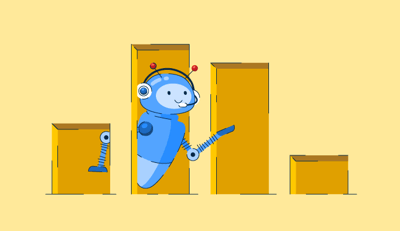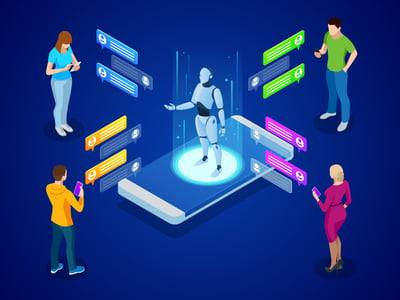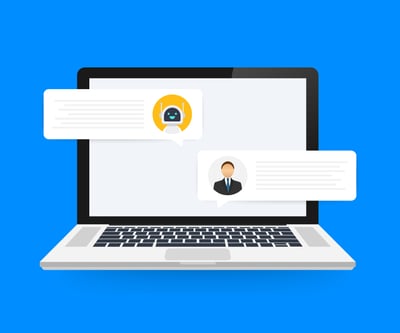July 11, 2025
 by Sagar Joshi / July 11, 2025
by Sagar Joshi / July 11, 2025

Chatbots aren’t just automating support tickets anymore; they’re qualifying sales leads, streamlining HR processes, and acting as always-on virtual assistants. Nearly 70% of Fortune 500 companies now use tools like Microsoft 365 Copilot to boost productivity and reduce manual workloads.
AI chatbot software has become integral across departments, from customer service to marketing. These tools offer a range of AI chatbot features that help people work more efficiently by saving time on routine tasks and making it easier to locate and use information. However, concerns remain around data privacy and reliability.
So what do the numbers really show about chatbot effectiveness, adoption patterns, and user trust? In this article, we’ll break down the latest chatbot usage statistics, revealing where these tools are delivering real efficiency gains, where they’re falling short, and what challenges still limit widespread adoption.
Let's take a look at how different business functions make use of chatbots and what outcomes people see with their personal use.
Below is an overview of chatbot usage in business and everyday tasks.
| Chatbot usage in a department/area | Result | Outcome in data |
| Customer support | Reduces human intervention and expedites issue resolution. | Chatbots are able to answer 80% of standard questions without human help. 90% of businesses reported faster complaint resolution after deploying bots in their support workflow. |
| Sales and marketing | Increases in lead generation and conversions. | Business leaders report an average 67% increase in sales through chatbot interactions. |
| HR and internal operations | Support in decision-making with decreased average referral time and increased employee engagement rate | 62% of people reuse a cognitive-enabled tool like a chatbot to support personal HR decision-making. |
| Online commerce | Improvements in sales, but improper implementation leads to customer frustration. | Businesses experienced a 67% increase in sales following chatbot implementation. |
| Healthcare | Offers healthy lifestyle suggestions, but users speculate about the risk of chatbots storing their health data. | 45% of Americans feel companies operating chatbots should never store their health data. |
| Personal productivity | Saves time while simplifying tasks. | 36% of Americans used AI chatbots to save time, and 35% wanted to simplify tasks. |
The rise of chatbots isn’t just a tech fad; tangible efficiency gains drive it. Below are several real-world areas where chatbots and AI assistants are making people and businesses more efficient.
Chatbots in customer service dramatically reduce the workload and costs for support teams. They autonomously handle a large portion of routine inquiries.
Bots can now manage up to 80% of standard questions without human help. This offloading of tasks translates to savings. According to one estimate, companies saved around 2.5 billion hours of work by using chatbots and reduced support costs by approximately $11 billion.
On a per-interaction basis, a typical chatbot session costs an average of $0.50, compared to $6.00 for a comparable human support query. If you’re evaluating options, understanding chatbot pricing across vendors can help forecast these savings more accurately
Customers benefit too: chatbots provide answers three times faster than human agents on average, leading to quicker issue resolution and higher satisfaction. It’s no surprise that 90% of businesses report faster complaint resolution after deploying bots in their support workflow.
AI-powered assistants are handling the bulk of simple support tasks, freeing human agents to focus on more complex issues while saving the company time and money.
Many companies use chatbots, including WhatsApp chatbots, as always-on sales reps and marketers, and the data shows significant benefits. 41% of chatbot deployments today are in sales, with another 17% in marketing. Its impact on lead generation has been impressive.
In some cases, chatbots achieve conversion rates as high as 70% in turning prospects into customers. They engage users instantly and personally. This translates directly into more revenue.
Business leaders report an average 67% increase in sales through chatbot interactions, and roughly 26% of all sales at these companies now start with a chatbot greeting or qualifying a customer. Crucially, chatbots don’t just initiate sales, they help close them.
Chatbots on the HR side are making teams more productive and efficient in their day-to-day operations. IBM’s chatbot, the watsonx Assistant, has reduced the time employees spend on everyday HR tasks by 75%. This time is helpful for more critical tasks at hand.
Similarly, at Slack, a Senior Software Engineer, Vasu Jain, observed a 100% referral flow going through a chatbot while decreasing the average referral time by 50%.
Beyond HR, companies use internal chatbots for IT helpdesk support, like resolving password resets or technical FAQs, and training employees on company knowledge. Honest Burgers, a UK restaurant chain, decided to use a chatbot for quick training modules, and it shot up to an engagement rate of 73%.
A BCG study highlights that a balanced human and AI strategy can increase HR productivity by up to 30% with the right mix of maturity, goals, and time. The statistics clearly indicate that AI offers significant value on the HR side, particularly in terms of efficiency and productivity.
Online retailers have adopted chatbots as virtual shopping assistants, yielding measurable gains in efficiency and revenue. Chatbots engage customers on e-commerce sites 24/7, answering product questions and guiding shoppers through the checkout process. 84% of organizations using AI in e-commerce report moderate to major improvements. Businesses experienced a 67% increase in sales following chatbot implementation.
However, on the customer front, the data tells a different story. An IBM report suggests only about 1/3rd of consumers who have used chatbots and virtual assistants are satisfied. In the same vein, around 20% of customers found chatbots and virtual assistants so disappointing that they didn’t want to engage with technology again. This is primarily due to the lack of training, capabilities, and skills needed in chatbots to understand basic requests and answer customer questions.
Even when AI excels in productivity, you need to implement it effectively. If it’s trained on inadequate or inappropriate datasets, it leads to poor CX and alienates both consumers and businesses.
AI and the Internet of Medical Things (IoMT) have numerous applications in consumer health. It allows a person to stay healthy and avoid going to a doctor, or at least not as often. AI chatbots provide healthier behavior suggestions to individuals, helping them proactively manage a healthy lifestyle.
In hospitals, AI is making it easier to detect diseases, such as cancer, more accurately. A study by the American Cancer Society suggests that a high proportion of mammograms yield false results. In 10 years, around 1 in 2 healthy women are being told they have cancer when they do not. AI is achieving accuracy in mammogram reviews and translations, making the process 30 times faster.
Although it’s displaying decent impact and benefit, there are some headwinds that keep consumers cautious. Around 45% Americans feel companies operating chatbots should never store their health data. Conversely, 29% of Americans were okay with companies using their data to train AI models.
Chatbots aren’t just for businesses. Individuals are using AI chatbots like personal assistants to increase their own productivity. The launch of advanced conversational AI models like OpenAI’s ChatGPT has increased consumer usage of chatbots for work, learning, and daily tasks.
As of early 2025, 34% of U.S. adults have used ChatGPT, roughly double the share reported in 2023 data. Young adults are leading the charge, with a majority of people under 30 now using AI chatbots. Why are so many turning to AI assistants?
About 23% of Americans who recently used an AI chatbot did so for writing or editing tasks. Americans used AI chatbots because they thought it would be fun (37%), save time (36%), or simplify tasks (35%). About 32% just enjoy trying new tech.
In the workplace, the share of U.S. employees who use ChatGPT for their job jumped from 8% in early 2023 to 28% by early 2025. These workers employ AI to help brainstorm ideas, generate reports, and automate routine tasks within their jobs. The net effect is that a growing number of individuals are partnering with AI chatbots as personal productivity boosters, accelerating tasks that used to take much longer.
With so many use cases and adoption trends emerging, choosing the right AI chatbot software is crucial to maximize these benefits.
Below are some additional statistics on chatbot usage, beyond those covered above.
Based on the data, it seems that chatbots offer promising gains for different departments in multiple sectors, provided that they are appropriately implemented. On one side, they deliver cost benefits, save time, and improve efficiency. However, if not implemented effectively, they can frustrate customers, with some going so far as to say that they waste their time and are of no use.
There is still speculation on how much people trust chatbots with their data, especially health information. There is a mixed opinion here. Some people are opposed to chatbots storing their health data, while others have no issues with the technology training itself on their data.
You must deploy chatbots carefully and train them on accurate data to promote healthy adoption while realizing their benefits.
Want to build a chatbot of your own? Explore ways to create and implement a chatbot effectively.
Sagar Joshi is a former content marketing specialist at G2 in India. He is an engineer with a keen interest in data analytics and cybersecurity. He writes about topics related to them. You can find him reading books, learning a new language, or playing pool in his free time.
Chatbots work 24/7, tirelessly striving to solve your stakeholders’ problems.
 by Sagar Joshi
by Sagar Joshi
With the popularity of online shopping and regular growth of the e-commerce market, demand for...
 by Rebecca Reynoso
by Rebecca Reynoso
If you’ve ever considered creating a chatbot for your company’s website, but weren’t sure...
 by Rebecca Reynoso
by Rebecca Reynoso
Chatbots work 24/7, tirelessly striving to solve your stakeholders’ problems.
 by Sagar Joshi
by Sagar Joshi
With the popularity of online shopping and regular growth of the e-commerce market, demand for...
 by Rebecca Reynoso
by Rebecca Reynoso


